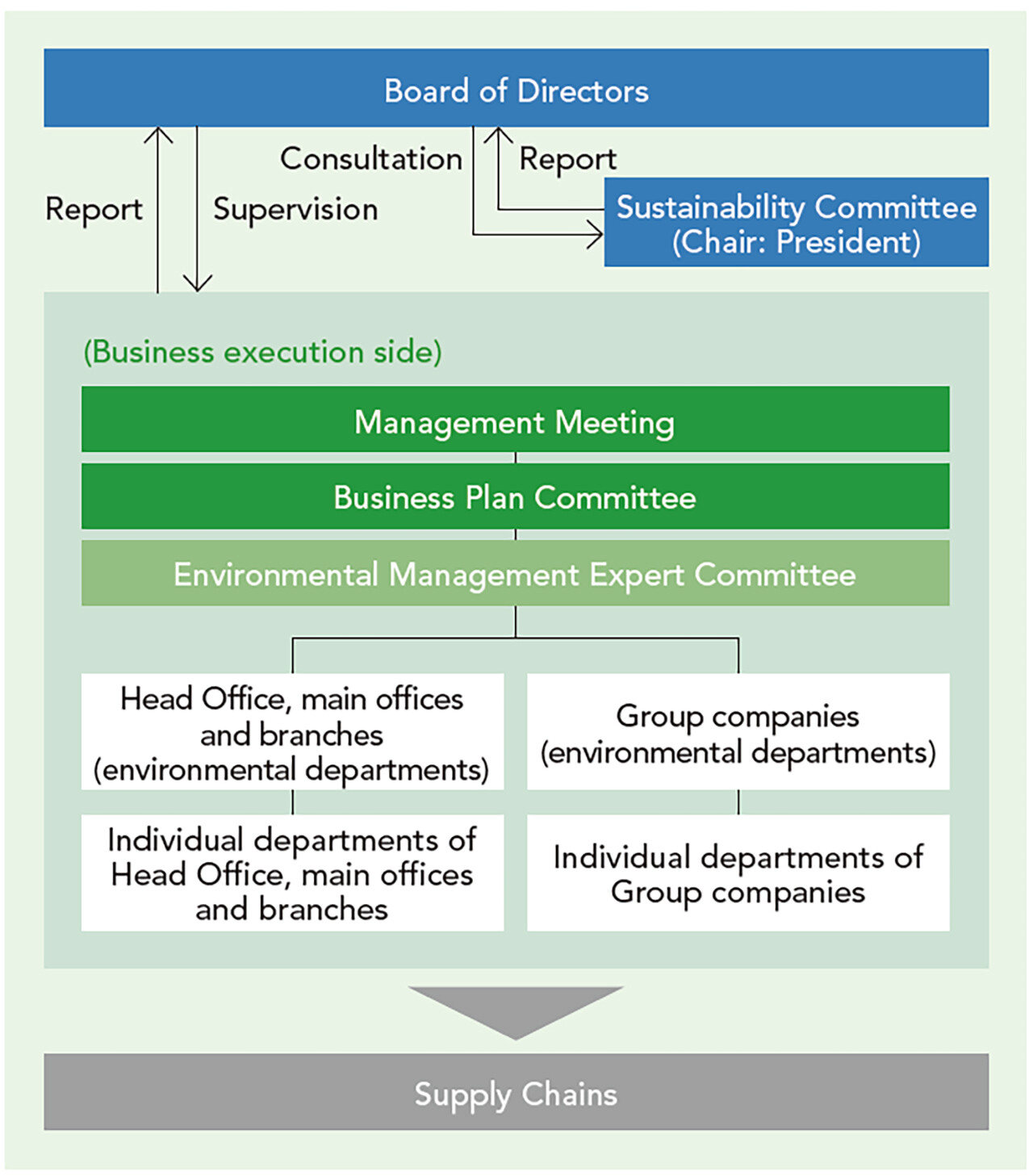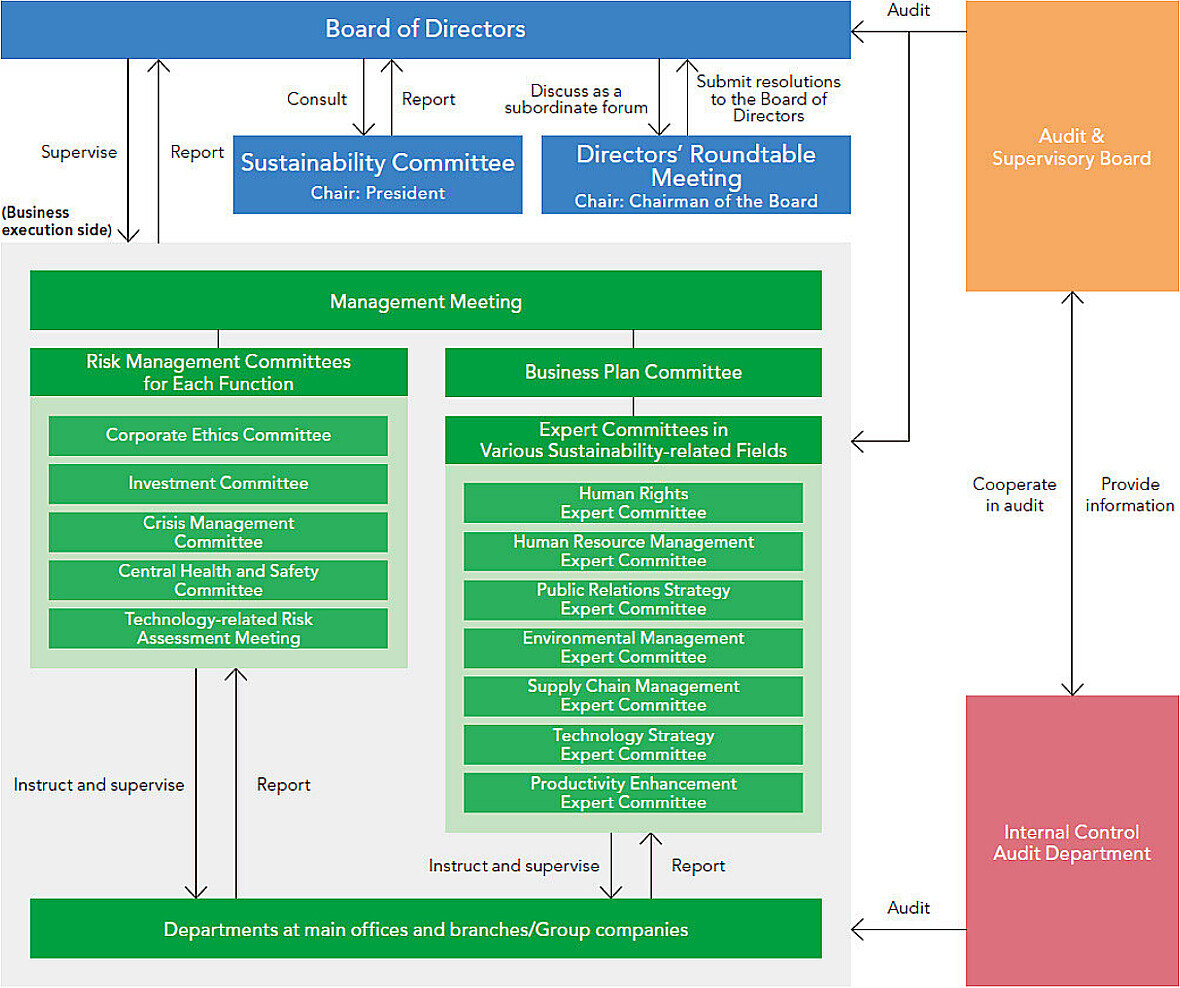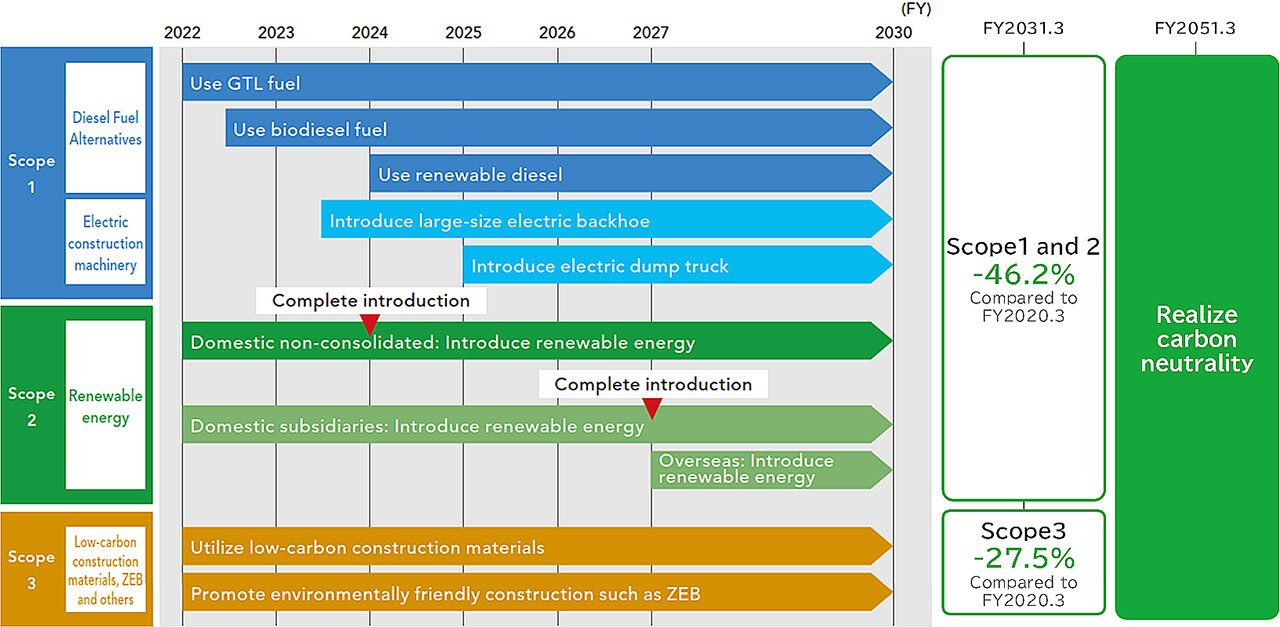Climate-Related Information Disclosure (Disclosure Based on TCFD Recommendations)
Having established the long-term vision "Obayashi Sustainability Vision 2050" and having set decarbonization as one of our targets for the years 2040 to 2050, Obayashi Corporation is working throughout our Group and supply chains to realize a sustainable society. Currently, we aim to realize this vision by conducting business activities designed to prevent global warming. These include setting "Establish an Environmentally Responsible Society," which includes reducing CO2 emissions, as one of our ESG Materialities.
In July 2020 we declared our support for the Task Force on Climate-related Financial Disclosures (TCFD). We conducted scenario analysis to identify and assess climate-related risks and opportunities and understand the medium- to long-term impacts that climate problems may have on our business, and then in November 2020, in light of our analysis results, we disclosed climate-related information based on the TCFD recommendations.
We updated our disclosures in April 2024 in response to needs in society, including the issuance of "IFRS Sustainability Disclosure Standards" developed by the International Sustainability Standards Board (ISSB) and the mandatory disclosure of sustainability information in annual securities reports.
Core Elements of TCFD Recommended Climate-Related Financial Disclosures
| Governance | Strategy | Risk Management | Metrics & Targets |
|---|---|---|---|
| The organization's governance around climate-related risks and opportunities | The actual and potential impacts of climate-related risks and opportunities on the organization's businesses, strategy, and financial planning | The processes used by the organization to identify, assess, and manage climate-related risks | The metrics and targets used to assess and manage relevant climate-related risks and opportunities |
Governance
Obayashi Corporation has established the Sustainability Committee that examines and discusses environmental and social sustainability issues as an advisory body to the Board of Directors, aiming to help ensure the effective and efficient monitoring, supervision, and involvement of the Board in sustainability issues. The Sustainability Committee, chaired by Representative Director, President and CEO, comprises Independent Directors and other members who have sustainability-related expertise and experience. It convenes to identify sustainability issues, including climate-related issues, to discuss and make recommendations on Obayashi's responses to the identified sustainability issues, and to review the implementation status of such responses by the execution side (including the management of the achievement of climate-related targets). Based on discussions at the Sustainability Committee, the Board of Directors determines management policies for promoting ESG management and achieving SDGs.
- Sustainability Promotion Framework(Sustainability Committee)
- Director Expertise and Experience (Skill Matrix)
On the business execution side, under the Management Meeting, the Business Plan Committee mandated by Representative Director, President and CEO, and the Environmental Management Expert Committee established in the Business Plan Committee, engage in developing, promoting, and monitoring the implementation of the Group's united measures in accordance with the management policies determined by the Board of Directors. In addition, the Audit & Supervisory Board audits the execution of duties by directors.
Governance System Concerning Climate Change

| Organization | Overview of organization | Overview of activities |
|---|---|---|
| Board of Directors |
|
|
| Sustainability Committee |
|
|
| Management Meeting |
|
|
| Business Plan Committee |
|
|
| Environmental Management Expert Committee |
|
|
| Environment Departments |
|
|
Strategy
Obayashi Corporation has developed "Obayashi Sustainability Vision 2050," identifying challenges to the Obayashi Group in its efforts in realizing sustainability as well as putting in place concrete action plans and key performance indicators (KPIs). Further, we have set carbon neutrality as our medium-term priority toward the achievement of the ideal Obayashi Group of 2050.
We have conducted scenario analysis to understand the medium- to long-term impacts climate-related problems may have on our business, and identify and assess climate-related risks and opportunities as outlined below.
Identification of Risks and Opportunities
When examining its business, strategic, and financial plans, the Obayashi Group also takes into account climate-change-related impacts as part of the processes of assessing impacts that climate-related risks and opportunities may have over the short term (in 3 years), the medium term (up to 2030), and the long term (from 2031 to 2050). We rank the degree of impact in three levels: major (10 billion yen or more), medium (1 billion yen or more and less than 10 billion yen), and minor (less than 1 billion yen).
-
Short-term risks and opportunities:
Meeting every half-year, the Environmental Management Expert Committee reviews and revises our key environmental protection measures and amends our standards in respect to gradually emerging risks and opportunities. -
Medium-term risks and opportunities:
We conduct appropriate, detailed analysis when setting our Medium-Term Business Plan and rolling plans. Moreover, during scenario analysis, we identified risks and opportunities that we anticipate could happen by 2030. Details may be found under the heading "Scenario analysis" below. -
Long-term risks and opportunities:
We review and revise our long-term vision "Obayashi Sustainability Vision 2050" as necessary.
Scenario Analysis
- Obayashi conducted a scenario analysis to identify and assess risks and opportunities and understand the medium- to long-term impacts climate problems may have on our business, as based on TCFD recommendations.
-
Our analysis used two scenarios: one in which the average global temperature in the year 2100 would be about 4°C above pre-industrial levels (the 4°C scenario), and one in which it would be about 1.5°C higher (the 1.5°C scenario). We analyzed transitions in policy and market trends (transition risks and opportunities) as well as analyzing physical changes resulting from such events as disasters (physical risks and opportunities) under each scenario. Typical scenarios that we used are as follows.
[Major scenarios used to analyze transition risks and opportunities]
- 4°C scenario: IEA(*1) Stated Policy Scenario (STEPS)(*2)
- 1.5°C scenario: IEA Sustainable Development Scenario (SDS)(*3)
[Major scenarios used to analyze physical risks and opportunities]
- 4°C scenario: IPCC(*4) RCP8.5(*5)
- 1.5°C scenario: IPCC RCP1.9(*6)
- *1 The International Energy Agency. The international organization aims to ensure energy security, economic development, environmental protection, and worldwide engagement. It is concerned with energy policy in general.
- *2 This scenario assumes that each nation's currently announced environmental policies will be realized, but the long-term targets of the Paris Agreement as agreed at the 21st Conference of the Parties (COP21) of the United Nations Framework Convention on Climate Change (UNFCCC) will not be achieved, and that climate change will cause global temperature to be about 4°C higher in the year 2100 than pre-industrial levels.
- *3 A scenario of achieving net zero CO2 emissions by the global energy sector by 2050 and keeping a climate change-related temperature rise in 2100 within 1.5℃ from pre-industrial levels.
- *4 An abbreviation of "Intergovernmental Panel on Climate Change." The organization, founded in 1988 by the World Meteorological Organization (WMO) and United Nations Environment Programme (UNEP), seeks to provide comprehensive evaluations of human-induced climate change, its impacts, and measures for adaptation and mitigation from scientific, technical, and socio-economic points of view.
- *5 A scenario that assumes no measures will be taken to contain greenhouse gas emissions and that temperatures will rise 2.6°C to 4.8°C above pre-industrial levels.
- *6 A scenario in which measures are taken to contain greenhouse gas emissions and a temperature rise is likely to be within 1.5℃ from industrial levels.
[Summary of Scenario Analysis Results]
- In the analysis process, we identified climate change-related transition risks and physical risks under each scenario. We then quantitatively and qualitatively verified the degree of impact each of about 30 risks could have on our business, ranking them as major, medium, or minor. The risks that we determined could have a major impact on our business were " tightening of decarbonization policies, laws, and regulations," "higher summer temperatures," and "more severe natural disasters." We also identified certain opportunities that could have a major impact on our business: "increasing need for energy conservation/renewable energy technology" and "national resilience initiatives." The affected durations are set based on an estimated period during which risks and opportunities of each item are likely to positively develop in light of moves of the government and international institutions.
- As a result of the analysis, we consider that we are capable of responding to identified climate-related risks both in the 1.5℃-scenario and the 4℃-scenario, and thus our strategies have resilience.
- To promote use of low carbon materials such as CleanCrete®, electric furnace iron frame, as well as wooden buildings, we have introduced internal carbon pricing (ICP). ICP unit price is set at 10,000yen/t-CO2 considering market unit price forecast by an external organization and with reference to the unit price reflecting the CO2 reduction effect of low-carbon materials. However, it will be revised accordingly in line with changes in market unit prices.
- Going forward, we will incorporate responses to the identified risks and opportunities into our Medium-Term Business Plan. We will strengthen our functions of identifying, assessing, and managing climate change and other medium- to long-term risks and opportunities. We will aim to expand business opportunities for the Obayashi Group and further reinforce our organizational resilience.
- T=Transition, P=Physical, R=Risks, O=Opportunities
| Item | Impact in 2030(*1) | Affected duration (*2) |
Measures | Related Web Sites |
||||||||||
|---|---|---|---|---|---|---|---|---|---|---|---|---|---|---|
| Overview | 4°C scenario |
1.5°C scenario |
||||||||||||
| T | R | Tightening of decarbonization policies, laws, and regulations (introduction of carbon taxes, etc.) |
|
Medium | Major | Medium- long term |
Promote energy conservation at construction stage (less fuel consumption, less electric power usage) | a | ||||||
| Reduce CO2 at construction stage (introducing diesel fuel alternatives and electricity from renewable sources) | a | |||||||||||||
| Work with supply chains to decarbonize construction machinery (Hybrid and Electric Construction Machinery, etc.) | a | |||||||||||||
| Increase construction waste recycling rate, use recycled and low-carbon materials | a,b | |||||||||||||
| Establish mid- to high-rise wooden building design and construction technologies and strengthen supply chains for domestic timber | c,d | |||||||||||||
| O | Increasing need for energy conservation/ renewable energy technology |
|
Minor | Medium | Short- long term |
Supply buildings that have high added value and outstanding environmental performance, such as ZEBs | a | |||||||
| Promote development and practical application of ZEB technology and low-carbon materials (low-carbon concrete, etc.) | a | |||||||||||||
| Enhance proposal and sales capabilities by specialized units in carbon neutrality and construction of wooden structures and interiors, etc. | e | |||||||||||||
| Promote the renewable energy business, the hydrogen business, and the PPA business, and utilize expertise in these areas | f | |||||||||||||
| Strengthen marketing capabilities of value-enhancing and energy-conserving renovation services for existing facilities by taking advantage of our proprietary technologies | g | |||||||||||||
| P | R | Higher summer temperatures |
|
Medium | Medium | Medium- long term |
Manage construction processes by paying due attention to the safety of construction workers | h | ||||||
| Further increase productivity and construction safety using labor-saving technology and ICT | l | |||||||||||||
| Promote the improvement of working conditions at construction sites through measures against heat stroke and work style reform | h | |||||||||||||
| Promote initiatives for improving hiring and retention rates of construction workers and helping subcontractors and suppliers with the succession of their businesses and technologies | j,k | |||||||||||||
| More severe natural disasters (typhoon, heavy rain, flooding, etc.) |
|
Medium | Minor | Medium- long term |
Strengthen ability to make BCP response during disaster by building strong networks with suppliers | l | ||||||||
| Promote disaster preparedness using hazard maps and ICTs | - | |||||||||||||
| Promote redevelopment projects to enhance environmental, disaster prevention, and business continuity performance | m | |||||||||||||
| O | National resilience initiatives |
|
Minor | Medium | short- long term |
Promote development and practical application of technologies to prevent and mitigate disasters and build national resilience | n | |||||||
| Strengthen marketing of infrastructure construction, maintenance, and repair | o | |||||||||||||
| Promote one-stop business including everything from surveys and inspections using ICT to evaluations, diagnoses, repair, and reinforcement | o | |||||||||||||
- *1 Impact : major (10 billion yen or more), medium (1 billion yen or more and less than 10 billion yen), and minor (less than 1 billion yen)
- *2 Affected duration : the short term (in 3 years), the medium term (up to 2030), and the long term (from 2031 to 2050)
- *3 Carbon tax is estimated by dividing into Japan, North America, Asia, and other regions and assuming unit costs.
- *4 Electricity prices are estimated based on unit price assumptions for Japan, North America, Asia, and other regions.
These scenario analysis results are not future prospects, and we conduct the scenario analysis to review resilience of our strategies against climate change.
- a Decarbonization Initiatives (Promote energy conservation at construction stage, Reduce CO2 at construction stage, Decarbonize construction machinery, Utilization of low-carbon materials, Promote and expand ZEB)
- b Waste Materials (Increase construction waste recycling rate) (Japanese Only)
- c WOOD VISION -Wood Technology- (Establish mid- to high-rise wooden building design and construction technologies) (Japanese Only)
- d Circular Timber Construction (Strengthen supply chains for domestic timber) (Japanese Only)
- e Establishment of the Carbon Neutral Solutions Department (Establishment of a new sales department dedicated to carbon neutrality) (Japanese Only)
- f Renewable Energy Initiatives (Renewable energy business,Hydrogen business, PPA business)
- g Renewal and renovation (Energy-conserving renovation services) (Japanese Only)
- h Health and Safety (Occupational Health and Safety Management, Countermeasures against heat stroke, Work style reform)
- i Advanced technology (ICT) (Further increase productivity and construction safety using labor-saving technology and ICT) (Japanese Only)
- j Initiatives to Secure Human Resources (Development of Construction Skilled Workers and Securing Human Resources)
- k Establishing "Business and Skills Aftertreatment Support Center" to resolve management issues of cooperating companies. (Japanese Only)
- l Obayashi Group CSR Procurement Policy (Establish a disaster risk management system with the supply chain)
- m Real Estate Development Business (Promote redevelopment projects to enhance environmental, disaster prevention, and business continuity performance)
- n Support for business continuity planning in the event of a disaster (Promote development and practical application of technologies to prevent and mitigate disasters and build national resilience) (Japanese Only)
- o Civil Engineering Renewal (Infrastructure maintenance and management) (Japanese Only)
Risk Management
Obayashi is committed to accurately assessing the risks associated with our business activities, preventing those risks from materializing, and minimizing the impact if they do. These efforts are key to enhancing our corporate value and fulfilling our social responsibility to stakeholders. As such, we have built a risk management system covering the entire Group.
Important decisions are referred to the Board of Directors and Management Meeting for discussion. These bodies determine and evaluate the risks of each agenda item. They discuss whether we have found a response that would be appropriate in case a risk is manifested, and then a decision is made on the item. As for risks associated with environmental and social sustainability, including climate risks, our Sustainability Committee specifies risks and opportunities, conducts relative evaluation, identifies the sustainability challenges, and formulates policies to address them. Then the Committee evaluates execution status and reports the results to the Board of Directors.
Each department assesses the risks inherent to its business processes and builds any necessary avoidance and mitigation measures into those processes before performing them. It reports any risk information to the Head Office risk management committee for each function and expert committee in various sustainability-related fields (the Environmental Management Expert Committee for climate-related risks), which gives instructions and supervision to main offices, branches, and Group companies. The Audit & Supervisory Board and Internal Control Audit Department audits each department's risk management functions.
We will continue to enhance risk management and strengthen our risk management system.
Risk Management System

Metrics & Targets
Obayashi Group has set CO2 reduction targets and is promoting efforts to reduce CO2 emissions in our business activities in order to achieve the "decarbonization" outlined in the Obayashi Sustainability Vision 2050. We have committed to Science Based Targets (SBT)(*1) to ensure we meet our reduction targets and acquired that certification in October 2022.
- *1 An abbreviation of "Science Based Targets." These are greenhouse gas emissions reduction targets that businesses set based on scientific grounds with the aim of achieving COP21's Paris Agreement long-term target of limiting climate change-induced warming to less than 2°C.
CO2 Reduction Targets and Results (Consolidated)(*2)
| Scope (*3)・Metric | Base year | Results | Target | ||
|---|---|---|---|---|---|
| FY2019 | FY2024 | FY2030 | FY2050 | ||
| Scope1+2 | Total amount of emissions Reduction rate |
377.5 | 291.2 ▲22.9 % |
203.1 ▲46.2% |
0 ▲100% |
| Scope3 (Category1+11) |
Total amount of emissions Reduction rate |
4,588.4 | 4,518.7 ▲1.5% |
3,326.6 ▲27.5% |
- |
- *2 All domestic and foreign group companies are covered.
- *3 Scope1:Direct emissions from business activities
- Scope2:Indirect associated with the use of energy (electric power, heat, etc.) in business activities
- Scope3:Other indirect emissions caused by supplier activities, product use, etc.
- Scope3 Category1:Purchased goods / services
- Scope3 Category11:Use of sold products


